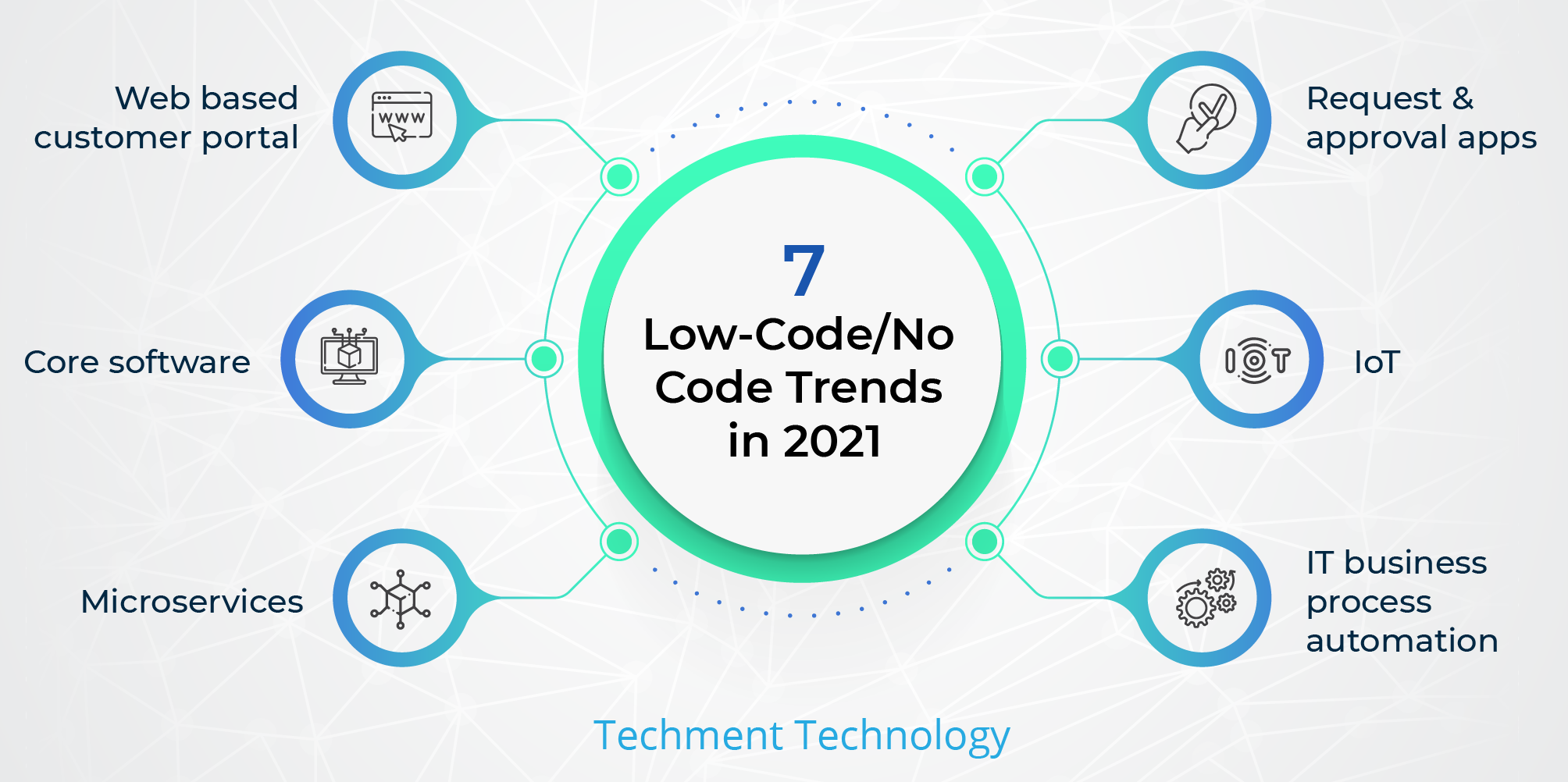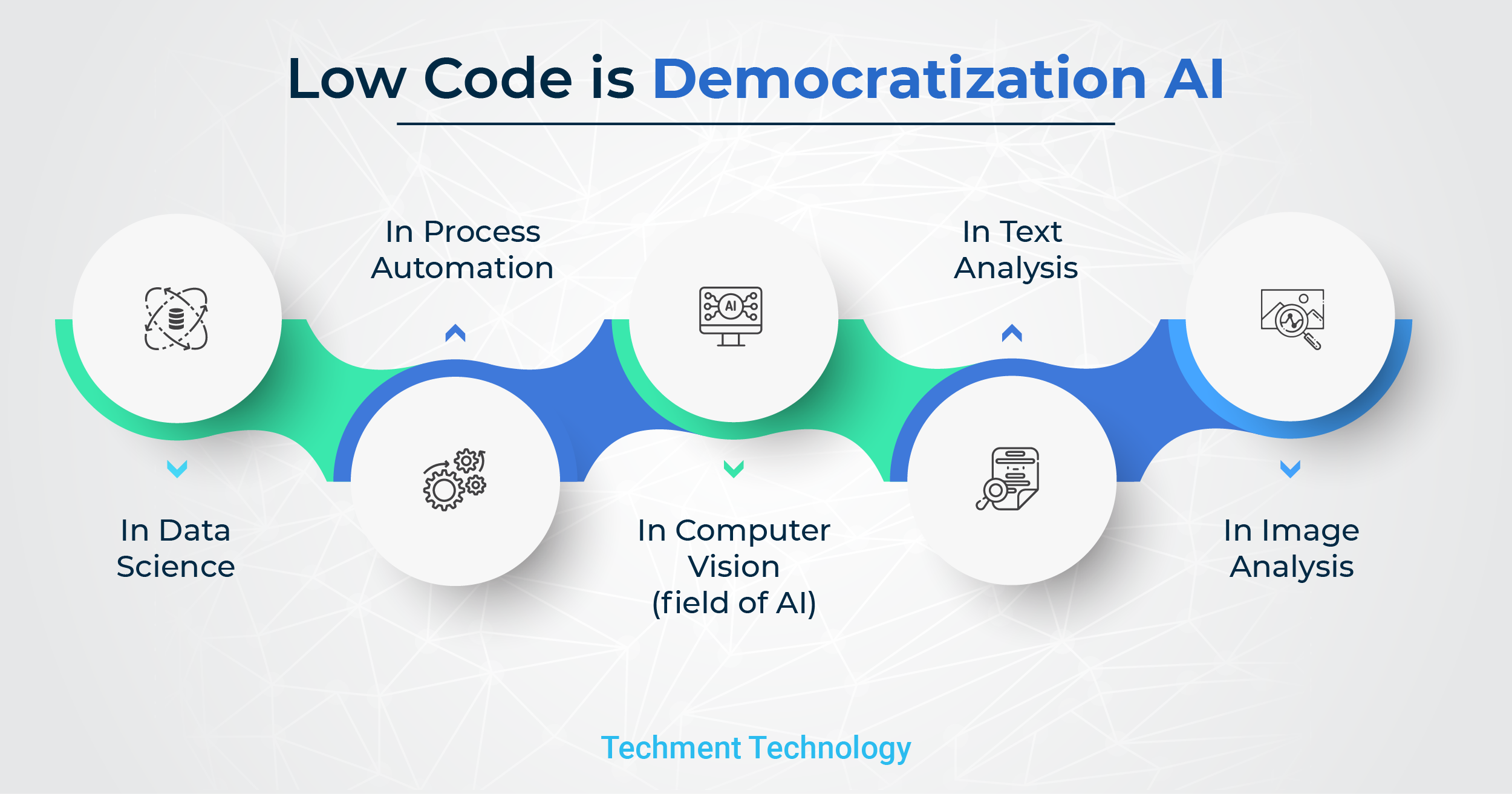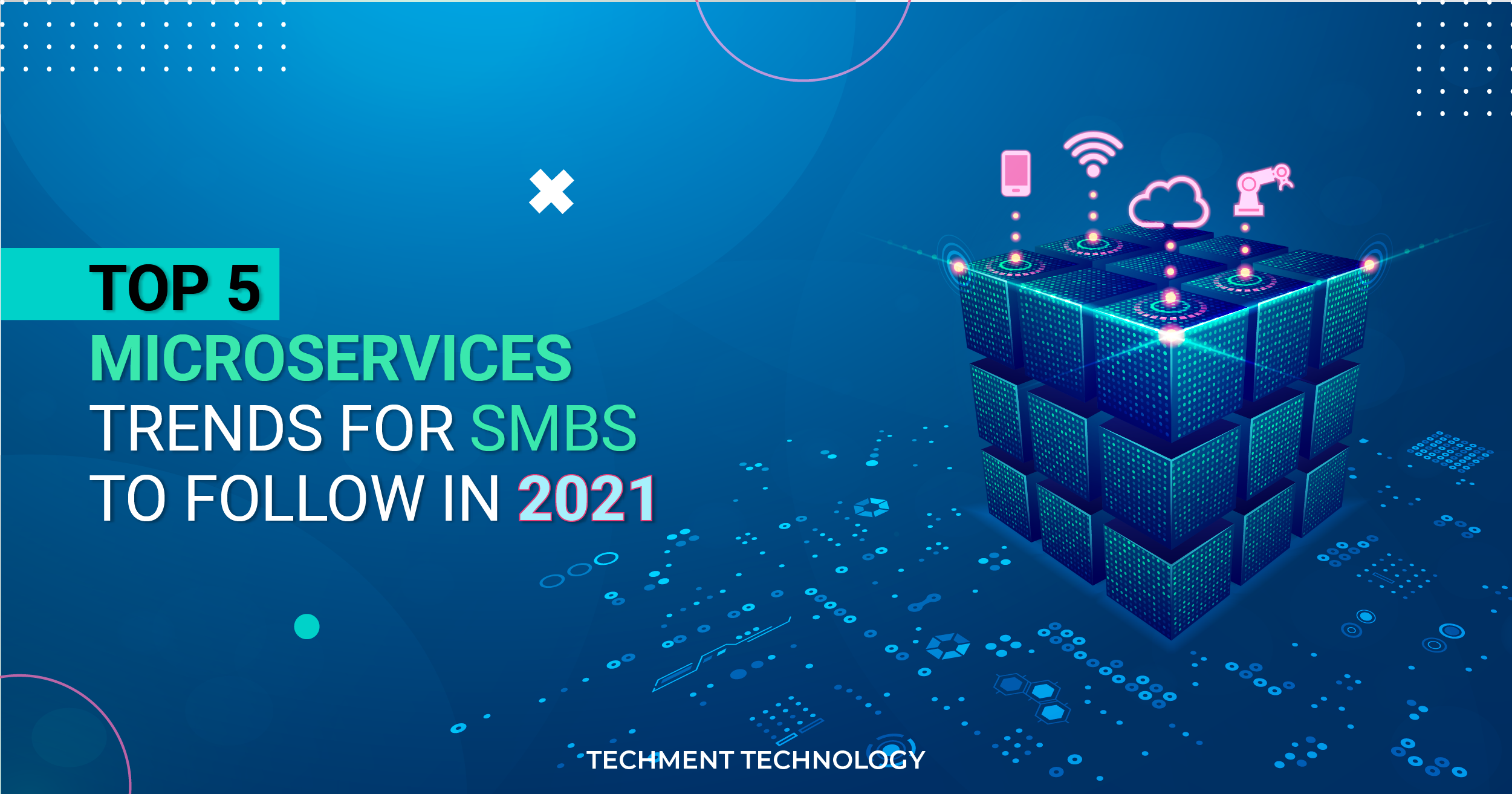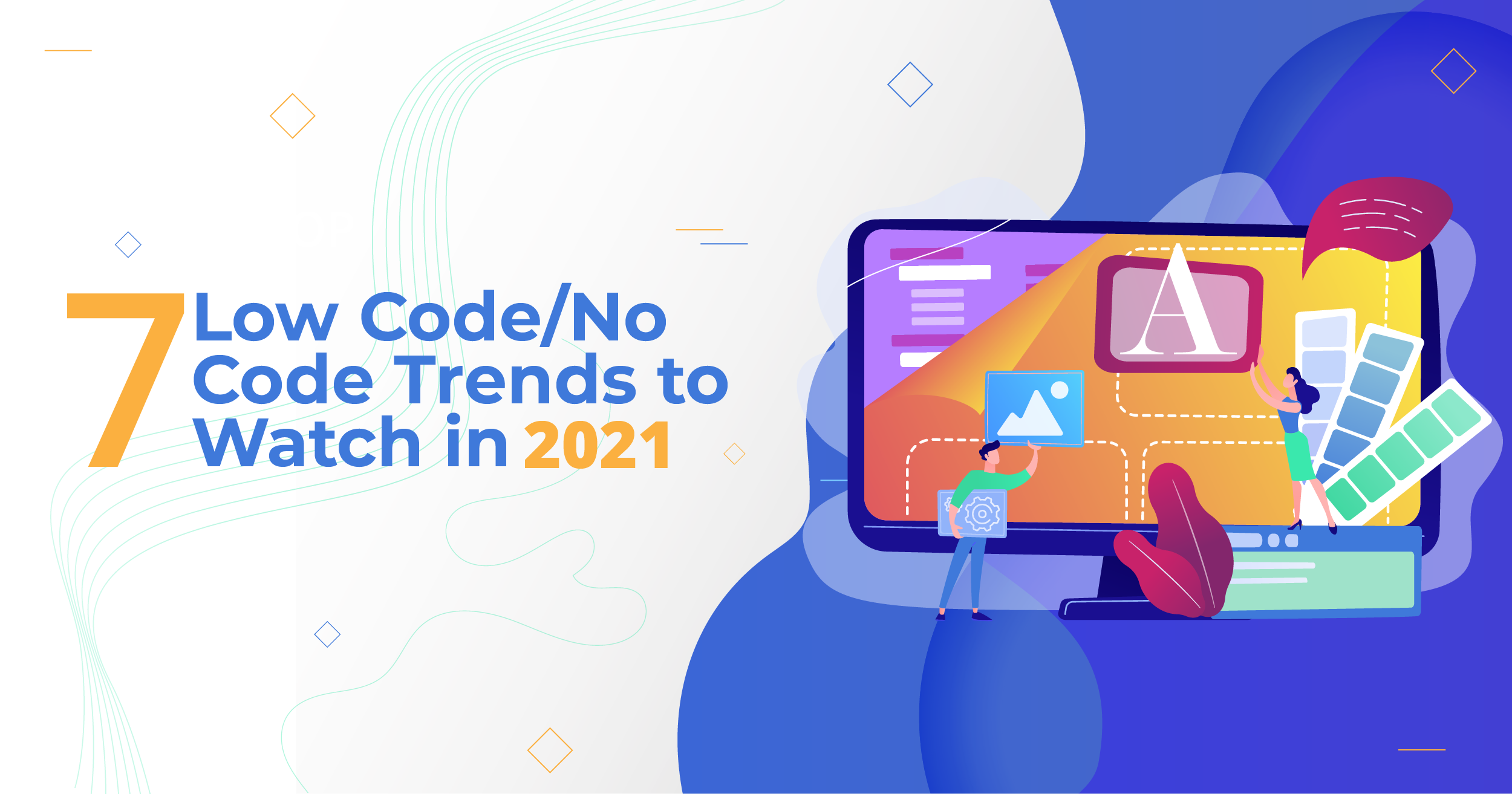Low code and No-Code tools are converging these days. A couple of years ago low code was simply about software development without coding, with the use of drag & drop tools; but recent years have seen the emergence of low code in several aspects like AI (Artificial Intelligence), RPA (Robotic Process Automation), etc. As low code does not require highly trained professionals for software development, it simplifies the development process and makes it accessible for a wide range of businesses.
AI is a high-tech niche in the software industry that performs tasks without human intervention, but developing AI platforms requires lots of coding with a higher degree of accuracy. In this case, companies planning to adopt AI can easily accept low code. Low code allows non-technical experts in coding to develop AI platforms efficiently.
7 Low-Code/No Code Trends in 2021

From core system development to online process portals for digitizing customers, there are several trends of low code. Glimpse of some are:
- Web based Customer Portals: Lots of companies want to provide a consistent customer experience and add new streams of revenue through web portals, but they also struggle to launch one because traditional web portals are slow, consume more resources, and are costly.
Low code unravels these pain points and allows developers to develop such portals quickly. Graphical UI can also be made appealing, additionally, the interface can be reused for different purposes.
- Core Business Software: Low Code applies a collaborative and rapid approach throughout the application lifecycle to ensure that business and IT departments work together to reduce the risk of project failure and deliver critical business applications in time. Apps built on low code platforms are cloud-based and multi-cloud portable, these applications are easy to scale, highly secure, and maximize uptime through critical resilience.
- In Microservice: Companies can use low code to accelerate the development of microservice applications. Starting with low-risk and high-impact functions, companies can use APIs to refactor monolithic applications into low-code microservices.
- In IoT: IoT apps are complex to build as they process lots of data from start to endpoint devices like sensors, communications devices, cars, mobile, etc. With low code, developers can seamlessly build such mobile applications which convert huge data into context-aware visuals for end users.
- In AI: With low code intelligent systems, applications can be built without much expertise. Developers can leverage the power of AI by clubbing it with low code development for building enhanced image & visual analysis.
- Request & Approval App: The electronic forms or processes used to approve paper budgets are error-prone, time-consuming, and opaque. Low Code provides professional and commercial developers with fast and flexible collaboration tools for digitizing the end-to-end capital application and approval process on a single platform. Can be accessed from multiple devices, respond quickly, and provide consumers with a high-quality user experience.
- IT Business Process Application: Low Code provides companies with the capabilities to access, use, and share server-side data, logic, and processes, as well as the ability to automate and change business processes, workflows and management applications. However, for some platforms, if you want to integrate these applications with other local systems, you must do a lot of manual programming.
Companies have found multiple ways to implement Low code with different technologies, as it provides solutions in a fraction of time. But not just speed, it has various other advantages such as;
- Faster Time to Value: Developing & deploying applications becomes faster.
- Easy Integration: Supports integration with existing systems & creation of APIs.
- Great UX: You can enhance performance by customizing, rebuilding or importing best designs.
- Modern Architecture: It also supports modern development architectures that ensures performance & transparency
How Low Code is Democratizing AI?
AI is a high-tech niche of computer science that requires hard work, experience, and vast technical knowledge. But Low Code has made it easier for non-professional developers to integrate AI easily with their technologies. Low-code AI has changed the mindset of AI product development by providing simple, intuitive, and easy-to-use solutions. The emergence of the Low-code AI development platform provides a ready-made building block for building AI solutions, in which users can use GUI and configuration to build applications in a few hours.
The cost-saving and time-saving parameters are indisputable, along with that it provides enterprises flexibility by hassle-free customization of apps. Low code AI allows non-AI developers to create AI applications from predefined components. It has the capabilities to bring transformation in various aspects.

- In Computer Vision (Field of AI): With Low-code, even technically inexperienced experts can quickly combine the required software applications and visualization components. You can quickly create custom AI vision solutions, allowing you to create applications for multiple computing platforms at the same time.
- In Data Science: Several open-source tools are very useful for machine learning beginners who have no programming experience. They have a combined interface of multiple models and algorithms, which simplifies the model training process. This allows you to train the model in a shorter amount of time, with just a few lines of code, without the need for in-depth knowledge of machine learning algorithms.
- Low Code AI in Process Automation: When it comes to automation, the process is difficult and also it needs constant evolution from previous processes. For maintaining error-free workflow the businesses need to upgrade with demands, so low code provides a flexible solution in speed.
- In Image analysis: Image analysis is the process of processing specific images to optimize them or extract valuable information from them. When AI is integrated with image processing it can help identify objects and actions in images or videos. Low code here allows us to quickly build applications. If you combine this approach with the potential of artificial intelligence, you will create intelligent solutions tailored to a large number of existing technical and non-technical challenges.
- Text Analysis: AI text analysis is the process of extracting information from a large amount of text data. The program uses natural language processing to understand and interpret data. Organizations use the program to greatly automate the process of understanding user feedback and comments, enabling the team to make data-driven decisions.
There are applications like MoneyLearn that can provide comprehensive text analysis and data visualization studios for unstructured text data to obtain topics, opinions, intentions, keywords, etc.
Limitations of Low Code AI
Though being an optimistic approach for non-technical developers, the Low Code AI comes with certain limitations.
- Limited Customization: Since Low Code is more about drag & drop and less coding, it provides limited customization options.
- Migration Issue: Some low code AI providers don’t allow migration of low code AI platforms with a different code. You are locked to use a specific platform as long as the app is running.
- Performance: If there is an overload of work, it may get difficult to handle it. This also limits the number of users.
- Security Issue: It can cause security issues as you don’t have control over what provider has offered you. It also can’t be altered which makes your app more vulnerable to attacks.
- You don’t own Your Source Code: You are most likely locked in case of owning your source code. You may sometimes get access to codes but these are not necessarily transparent to you.
Future of Low Code AI
Although low-code development is a modern application development method, many mobile application companies and even entrepreneurs are adopting this method. Not all types of applications can be developed using this method. You can easily develop fewer functions.
Although companies and decision-makers in the corporate world believe in the bright future of artificial intelligence and the power of this technology, many of them still cannot start adopting artificial intelligence. The main reasons are cost and lack of highly qualified experts.
Low-code is ushering in a brand new technology of AI democratization. Citizen and professional AI builders can use those gear to boost up AI manufacturing. Enterprises and organizations must put more energy towards developing AI models with professionals and find better ways to implement Low Code with AI to enhance software development.
 All Posts
All Posts


